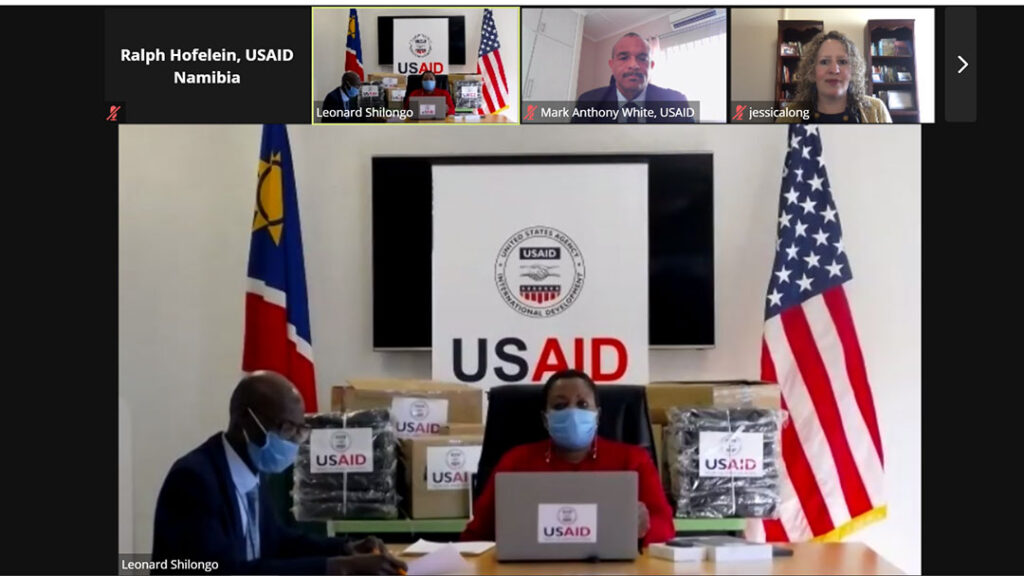ADF STAFF
The U.S. government donated 176 tablet and 53 laptop computers and 250 remote temperature-monitoring devices to Namibia as the nation struggled to kick-start its COVID-19 vaccination campaign amid rising mortality rates.
The $675,000 equipment donation will help register and monitor people at vaccination sites and help train more than 500 Health Ministry staff members. The U.S. has donated more than $6.7 million toward Namibia’s COVID-19 response.
“Getting the population vaccinated is key to fighting COVID-19 in the country and for the world,” Jessica Long, officer in charge of the U.S. Embassy in Namibia, said during a virtual handover ceremony. “The U.S. government remains committed to supporting the Ministry of Health and Social Services in its battle against this horrible pandemic.”
The July 22 delivery was timely. A week earlier, the BBC reported that Namibia had the world’s highest daily COVID-19 death rate, at 22 per 1 million people.
At the time, Marley Ngarizemo, a retired member of the Namibia national football team, said 15 members of his family had died of COVID-19 and another six were hospitalized.
“You do not know whether the world is ending,” Ngarizemo told the BBC. “You can compare it to a tsunami, you can compare this to a volcano, you can compare it to genocide. I don’t know. It’s like there is poison in the water, and every drop you take might have it or might not have it.”
At a COVID-19 isolation center hospital in the capital, Windhoek, health care workers bemoaned a lack of beds and medical oxygen. Donnovan Soresbeb, a nurse at the center, said he and his co-workers were physically and emotionally exhausted.
“You lose patients that were okay a few minutes ago. You turn your back, and then they’re gone,” Soresbeb told the BBC. “Some are [staying] so long in hospital that you kind of give up on them, and it is hard, but you keep hoping for the best.”
The vast majority of Namibians who succumbed to COVID-19 were not vaccinated, Prime Minister Saara Kuugongelwa-Amadhila told Namibian newspaper New Era. She added that a lack of vaccines coupled with vaccine hesitancy driven by misinformation likely contributed to the high mortality rate. COVID-19’s highly contagious Delta strain first was reported in Namibia in July.
Namibia launched its “Get Vaccinated, Help Kick Covid-19 Out of Namibia” campaign on August 6. The effort aims to disseminate timely and accurate information, generate awareness and alleviate fears about COVID-19 vaccines. The country must vaccinate 10,000 people a day to reach its goal of inoculating 60% of its population by December.
“We need to build capacity for our people to be able to differentiate between fake news and factual information for them to be able to make informed decisions,” Kuugongelwa-Amadhila told New Era.
Dr. Charles Sagoe-Moses, the World Health Organization’s (WHO) representative to Namibia, characterized vaccine hesitancy as “an old phenomenon.”
“In 2019, the WHO listed vaccine hesitancy as one of the 10 global public health threats,” Sagoe-Moses told the newspaper. “Delay and hesitancy to get vaccinated have caused many infections and deaths in the third wave.”
Namibia had fully vaccinated nearly 53,000 people — or 2.1% of its target — and more than 173,000 had received at least one dose of COVID-19 vaccine as of August 6, New Era reported.
Vaccine deliveries to Namibia and many other countries stalled in April when dwindling supplies forced India’s Serum Institute to hold shots for domestic use. The institute delivers vaccines to Africa through the COVAX plan to distribute the jabs equitably.
Hope arrived in mid-July when Namibia received 250,000 COVID-19 vaccines. The country received an additional 75,000 shots on August 8 with more expected in the coming months.

